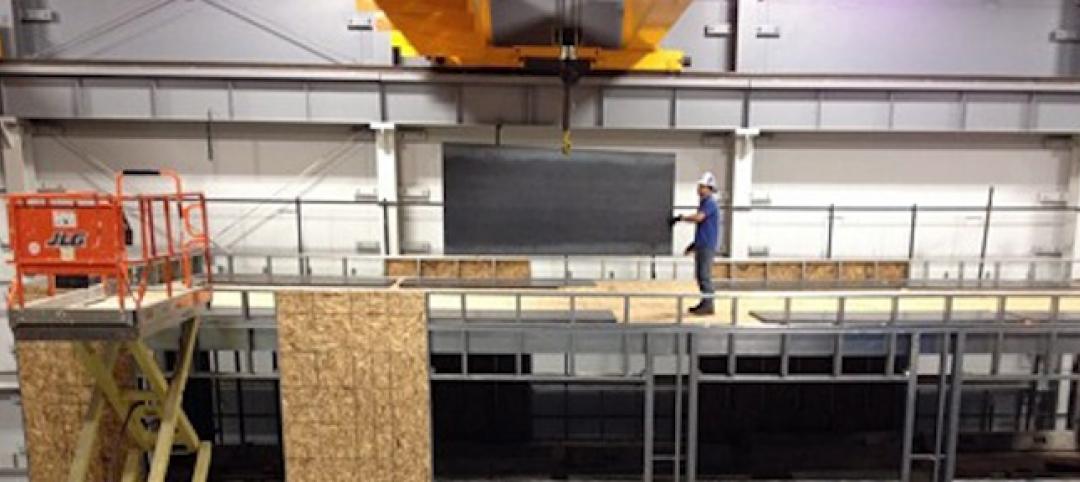
In the days when three-quarters of America was a wild, lawless no-man's land, Pioneer Courthouse in Portland, Ore., stood out as a symbol of justice and national unity. The oldest surviving federal structure in the Pacific Northwest and the second-oldest courthouse west of the Mississippi, Pioneer Courthouse was designed in 1875 by Alfred Mullett, the Supervising Architect of the Treasury. His dramatic three-story, cupola-capped Romanesque monument served as the focal point of Pioneer Courthouse Square, a public plaza in the heart of the City of Roses.
 |
| PHOTOS: MICHAEL MATHERS |
As years went by, however, it became clear that all was not well with this historic landmark. Made of completely unreinforced masonry, the courthouse was at high risk for earthquake damage: one big shake and the whole thing could come toppling down. The threat mobilized a team of government agencies, including the U.S. Court of Appeals, the National Trust for Historic Preservation, and the General Services Administration, into action in 1995. Together, they determined that Pioneer Courthouse needed an upgrade beyond the basic restoration: It would need to be made earthquake-proof, modern and safe, and energy efficient.
Quake, rattle, and roll
The Building Team—led by Donald Eggleston, AIA, of SERA Architects, and Jerry Abdie, of structural engineer KPFF Engineering—had one main concern: earthquake protection. Seismic upgrades comprised $12 million (60%) of the $20 million project cost. The goal was to create a system that would allow the courthouse and the ground to move independently of each other during an earthquake. To achieve this, the team chose to install Oregon's first friction pendulum ground base isolator system.
Comprised of lubricated sliding bearings set into a spherical stainless steel dish, the isolators support the weight of the building and allow it to move in one piece during an earthquake, rather than falling apart as various bits move in different directions. Seventy-five of these isolators were installed beneath the courthouse, each specially tailored for the response requirements of its specific position.
 |
| PHOTOS: MICHAEL MATHERS |
In order to install them, the team had to support the courthouse on pilings and remove the entire original foundation, replacing it with a new pile and pile cap system set below the isolators. Each isolator takes up just one square foot—meaning that the full weight of the courthouse's 24 million pounds now rests on 75 sf of space.
Upgrades to the HVAC, plumbing, and electrical systems (by M/E engineer Paul Schwer or PAE Consulting Engineers, Doug Grassman of contractor J.E. Dunn Northwest, and Bob Brott of CM Art Anderson Associates) also were made with earthquake protection in mind. The new piping in Pioneer Courthouse was designed to be able to withstand three-dimensional motion. Water connections are now able to flex up to 18 inches in any horizontal direction and one inch vertically, which allows them to absorb ground motion instead of breaking under its force. The courthouse is now one of only three buildings in Oregon with a flexible electrical connection system.
Reduce, reuse, remodel
With most of the budget taken up by earthquake proofing, the rest of the work had to be done in an extremely cost-efficient manner. As a result, adaptive reuse became the theme. For example, the original scrolled lighting fixtures were protected in place during construction and later retrofitted with energy-conserving compact fluorescent bulbs. Whole rooms were recycled into new uses, while maintaining their essential historic character. The former post office and mail sorting room became a new main entrance and expanded, state-of-the-art law library. This transformation required the removal of vinyl asbestos tile flooring and an acoustical drop ceiling, which had concealed the original terrazzo floors and decorative wood beam ceiling. Original color schemes and detail work were revived throughout the building, thanks to extensive research of historic photographs, news articles from the Oregon Historical Society archives, and early construction photos preserved by the General Services Administration.
 |
| Among the interior upgrades was the construction of a video conference alternative dispute resolution room where parties can work out their disagreements. PHOTOS: MICHAEL MATHERS |
The interior was also given a major security upgrade. Home to the U.S. Court of Appeals, the building needed to meet the federally mandated safety requirements for this high-risk profession. Surveillance cameras were placed on the building's exterior to act as a visual deterrent. Inside, five underground parking spaces were installed to give the judges a direct, private route from their vehicles to a secure building area.
Motion sustained
Sustainability was also emphasized, notably in the building's HVAC system. The old Pioneer Courthouse had been heated and cooled by an electric boiler, which, besides being extremely inefficient, left occupants with little ability to control their own individual environments. During renovation, this system was replaced by a pair of high-efficiency air handlers and an evaporative chilled-water cooling tower. This system divided the building into small zones, allowing occupants to adjust the temperature in their areas without greatly increasing operational costs.
Also important to the project was the use of materials that were both environmentally friendly and historically accurate. The team used wool carpeting instead of synthetics, formaldehyde-free MDF, linoleum floors instead of vinyl, and high fly-ash concrete—all of which helped minimize the courthouse's ecological footprint. More than 60% of all the construction waste was recycled and diverted from landfill.
As a result, since opening in October 2005, the newly remodeled Pioneer Courthouse's electrical usage is down 30% compared to the same period a year before its renovation.
Related Stories
| Jul 11, 2013
Lawsuit challenges modular apartment project in New York City
A plan to build pre-fab apartment buildings at Atlantic Yards in Brooklyn, N.Y., has been challenged by a lawsuit filed by the Plumbing Foundation in Manhattan Supreme Court.
| Jul 10, 2013
World's best new skyscrapers [slideshow]
The Bow in Calgary and CCTV Headquarters in Beijing are among the world's best new high-rise projects, according to the Council on Tall Buildings and Urban Habitat.
High-rise Construction | Jul 9, 2013
5 innovations in high-rise building design
KONE's carbon-fiber hoisting technology and the Broad Group's prefab construction process are among the breakthroughs named 2013 Innovation Award winners by the Council on Tall Buildings and Urban Habitat.
Sponsored | | Jun 30, 2013
Get your 'Early Bird' entry in for BD+C 30th Annual Reconstruction Awards
The deadline is for BD+C's 30th Annual Reconstruction Awards is July 19, but if you get me a draft of your entry by July 12 (earlier if possible, please!), we'll read it and give you feedback and suggestions that could help you win. We'll give you enough time to rework your entry in time to meet the deadline. We do this "Early Bird" service to help you put together the best possible entry - one that will answer any questions our distinguished jury members may come up with. However, we must emphasize that the BD+C Reconstruction Awards program is a juried competition, so there are no guarantees you'll win. We're just trying to improve your odds. Building Design+Construction is the only publication in its field to recognize the importance of reconstruction in all its forms - historic preservation, adaptive reuse, renovation, fitouts, and reconstruction with addition. And we've been doing it for 30 years. Incidentally, reconstruction accounts for 30-35% of all revenue for AEC firms, so it's a key component of the US/Canada design and construction industry. Send your draft entry to: rcassidy@sgcmail.com. And good luck!
| Jun 28, 2013
Calculating the ROI of building enclosure commissioning
A researcher at Lawrence Berkeley National Laboratory calls building enclosure commissioning “the single-most cost-effective strategy for reducing energy, costs, and greenhouse gas emissions in buildings today.”
| Jun 28, 2013
A brief history of windows in America
Historic window experts from Hoffmann Architects look back at the origin of windows in the U.S.
| Jun 28, 2013
Building owners cite BIM/VDC as 'most exciting trend' in facilities management, says Mortenson report
A recent survey of more than 60 building owners and facility management professionals by Mortenson Construction shows that BIM/VDC is top of mind among owner professionals.
| Jun 27, 2013
Thermal, solar control designs can impact cooling loads by 200%, heating loads by 30%
Underestimating thermal bridging can greatly undermine a building’s performance contributing to heating load variances of up to 30% and cooling load variances of up to 200%, says the MMM Group.
| Jun 20, 2013
Virtual meetings enhance design of University at Buffalo Medical School
HOK designers in New York, St. Louis and Atlanta are using virtual meetings with their University at Buffalo (UB) client team to improve the design process for UB’s new School of Medicine and Biomedical Sciences on the Buffalo Niagara Medical Campus.
| Jun 14, 2013
Purdue, industry partners test light steel framing for seismic safety
A partnership of leading earthquake engineering researchers from top U.S. and Canadian universities and design professionals from the steel industry have begun the final phase of a three-year project to increase the seismic safety of buildings that use lightweight cold-formed steel for their primary beams and columns.















